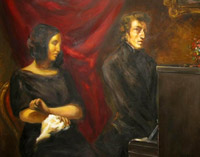period: Romantic
 The term “Romanticism” was first applied to trends in literature in the late-18th century, as an idealized revival of the Medieval “romance”, and soon spread to its sister arts, painting and music. In each of these, the term embraces a belief in the power of human emotions, and especially in the vital expression of an artist’s innermost “truths” – in defiance of the rule-bound traditions of the preceding age. In music history, the term generally refers to the period between Beethoven’s maturity and the rise of the Modernist trends of the early 20th century; at the same time, it has become common to draw a division between the (Early) Romantic and Late- or Post-Romantic eras – such as is adopted here.
The term “Romanticism” was first applied to trends in literature in the late-18th century, as an idealized revival of the Medieval “romance”, and soon spread to its sister arts, painting and music. In each of these, the term embraces a belief in the power of human emotions, and especially in the vital expression of an artist’s innermost “truths” – in defiance of the rule-bound traditions of the preceding age. In music history, the term generally refers to the period between Beethoven’s maturity and the rise of the Modernist trends of the early 20th century; at the same time, it has become common to draw a division between the (Early) Romantic and Late- or Post-Romantic eras – such as is adopted here.
The principal musical trends of the 19th century stem not so much from the introduction of new musical techniques or systems, but rather from an increased accentuation on those elements found already in 18th century music – newly driven by the Romantic ideals of subjective expression and organic unity. For example, the chromatic (sophisticated) harmonies found in the late string quartets of Beethoven, Franz Schubert, or Felix Mendelssohn follow directly from the harmonic developments of Mozart and Haydn, though are heightened to a degree beyond what might have occurred without the noted aesthetic impetus. Similar trends can be seen in the new, sometimes exotic approach to orchestration heard in the symphonic works of Hector Berlioz and Carl Maria von Weber, with natural evolution being pushed by philosophical imperatives. Social and cultural trends likewise made their impact on musical practice in the first half of the 19th century, most notably the coming of age of the middle class, and the related decline in the nobility; composers now had to respond more directly to the demands of the “public”, and less to the whims of a wealthy patron. Among the notable consequences of this latter trend was the birth of the private musical salon, and the great works written for them: the piano miniatures of Frédéric Chopin and Robert Schumann, the songs of Schubert and Schumann, etc. Another consequence was a new fascination with the virtuoso soloist, satisfied by the technical prowess required by the works of Niccolò Paganini and Franz Liszt. Perhaps nowhere was the combination of the Romantic impulse and market forces more palpable than in early 19th-century opera – where composers such as Weber, Gioacchino Rossini, Vincenzo Bellini, and Gaetano Donizetti ushered in a new era of opera both artistically and in terms of popularity. By 1850, the Romantic aesthetic had fully ripened, and composers sought ever more potent ways to infuse their works with emotion and unity, yielding a new era – the so-called Late Romantic period.

Nolan Gasser, PhD
Artistic Director













